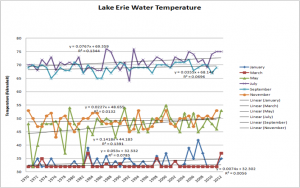At approximately 9,940 square miles, Lake Erie is an incredibly important component of the Great Lakes1. Whether it is due to the lake’s aesthetic value or its economic importance, Lake Erie is an ecosystem that is heavily monitored and researched. This monitoring has revealed a couple of very concerning trends that seem to be intensifying as a result of anthropogenic disruption and alteration. Regardless of whether it is the well-known algae blooms caused by increasing levels of dissolved phosphorous finding its way to the lake from agricultural and urban management practices or the introduction of invasive species and their effects on native fish populations, humans are disrupting the natural ecosystem of the lake at concerning levels2. One of the monitored aspects of the lake is the temperature of the water within the lake. Studies have shown that water temperatures have become warmer over the past 90 years6. Although the warming temperature is rather inconsistent in nature, resulting in up and downs in temperature on a year-to-year basis, linear trend lines indicate that water temperatures are getting warmer (refer to figure below). Water temperature readings are reaching all-time highs in the summer months and increased winter water temperature are resulting in decreasing ice cover4. Although a topic for debate, these increases in water temperature are largely a result of increased air temperatures resulting from climate change4. Understanding how these changes to the water temperature of Lake Erie may effect the organism within the lake is essential to future management and conservation strategies.

Short, Warm Winters Affect Successful Reproduction of Yellow Perch

The Lake Erie Yellow Perch (Perca flavescens) is a staple fish found in Lake Erie due to its relative importance ecologically, as well as, economically. With a harvest limit of 11.081 million pounds of total allowed catch in 2014, one can easily understand the importance of understanding the Yellow Perch physiological demands in order to best manage this species5. The Yellow Perch has a set of preferred reproductive traits and procedures that have proven essential to maintaining a healthy native population in Lake Erie. Female Yellow Perch develop ovaries in the cold winter months and spawn during the spring months3. With this in mind, studies have been conducted in order to understand how increases in water temperature resulting from warmer, shorter winters could affect the spawning success of this species. Results indicate that there are two main disruptions that arise from these shorter and warmer winter weather patterns. First, it seems that shorter and warmer winters are causing reduced size in Yellow Perch eggs, yielding smaller and less successful larvae3. In turn, this means that a reduced number of juvenile fish are advancing to the next life stage, potentially resulting in the reduction of overall surviving adult Yellow Perch in the lake. In addition, the spawning time of the Yellow Perch seems to be earlier than that of what it is typically seen under normal winter lake conditions. As seen in the figure below, spawning periods occurring around two weeks to a month earlier in shorter and warmer winter when compared to the typical longer and colder winters3. These unconventional spawning periods lead to increased food scarcity for surviving Yellow Perch juveniles, further impacting survival rates4. The study, run in an experimental setting and confirmed by actual lake conditions, show that the Yellow Perch is unable to adapt to the changing environmental conditions3.

Lake Erie Yellow Perch Population Dynamics & Impacts of Continuing Climate Change
Research has confirmed that Yellow Perch are negatively impact by shorter and warmer winters resulting from climate change, therefore it is imperative to continue researching just how fast this species is able to adapt in order to avoid a drastic population crash. The figure below indicates that Ohio temperatures will continue to increase with the consequences occurring whether we decrease carbon emissions or not7. Since the Yellow Perch is such a prominent species within the seven-billion-dollar fishing industry in the Great Lakes, a decrease in the perch population or a potential behavioral response to move out of the warmer regions of the lake could have monumental consequences to regional economies4. In addition to Yellow Perch, further research as to how other species of fish may be impacted by these warming trends could inform conservation efforts for a wide range of operations, not just recreational and commercial fishing.

References:
-
Lake Erie Facts and Figures. Retrieved November 1, 2017, from http://www.great-lakes.net/lakes/ref/eriefact.html
-
Michalak, Anna M. et al. “Record-Setting Algal Bloom in Lake Erie Caused by Agricultural and Meteorological Trends Consistent with Expected Future Conditions.” Proceedings of the National Academy of Sciences of the United States of America16 (2013): 6448–6452.
-
Farmer, T.M., Marschall, E.A., Dabrowski, K., Ludsin, S.A. (2015). Short winter threaten temperate fish populations. Nature Communications, 6 (7724)
-
Linn, M (2015, September 20) Climate change threatens perch, other warm-water fish. November 1, 2017, retrieved from http://greatlakesecho.org/2015/09/30/climate-change-threatens-perch-other-warm-water-fish/
-
Golowenski, D (2014, April 6) Lake Erie perch, walleye bag limits to stay same. Retrieved November 2, 2017, retrieved from http://www.dispatch.com/content/stories/sports/2014/04/06/lake-erie-perch-walleye-bag-limits-to-stay-same.html
-
Frankson, R., K. Kunkel, S. Champion and D. Easterling, 2017: Ohio State Summary. NOAA Technical Report NESDIS 149-OH,4 pp.
-
https://statesummaries.ncics.org/oh






